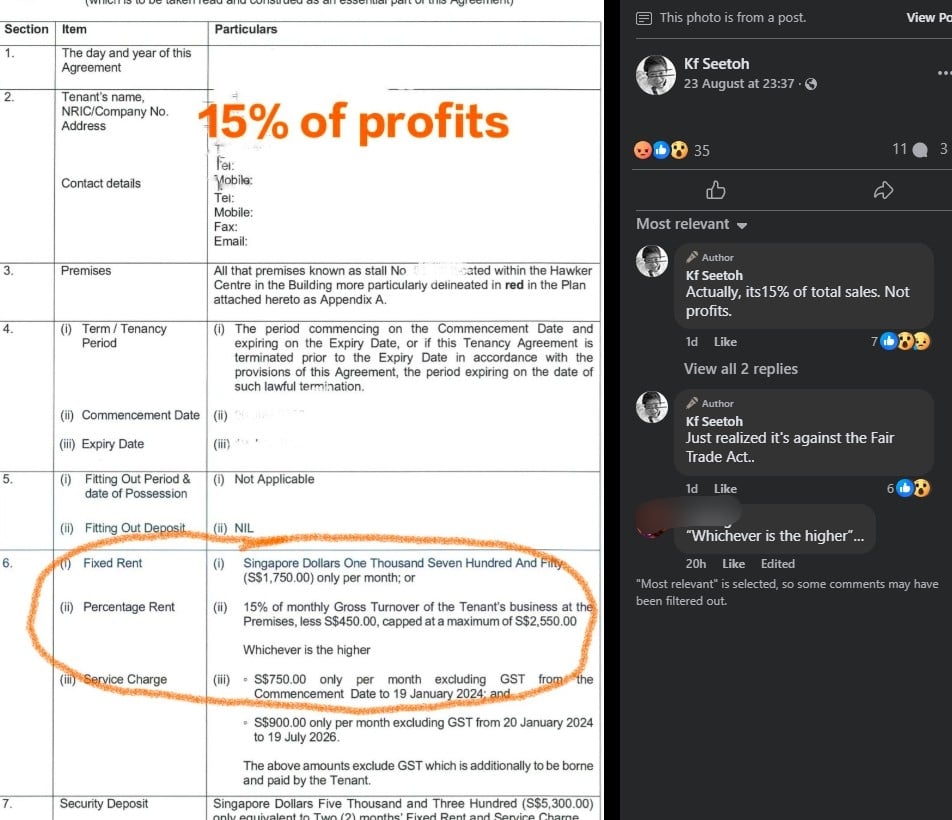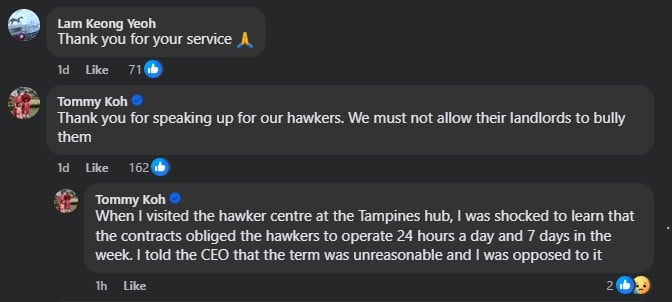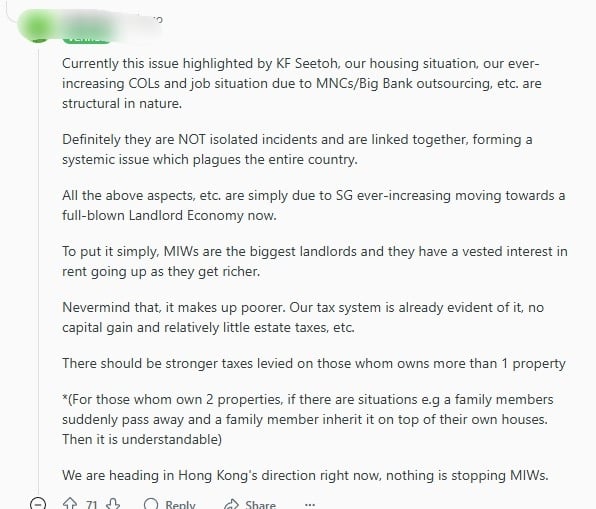On 23 August 2025, Singapore’s food critic and hawker culture advocate KF Seetoh renewed his attack on the social enterprise hawker centre (SEHC) model.
He described the system as “fundamentally flawed” and warned that it enabled landlords to exploit hawkers.
His post quickly went viral on Facebook, drawing widespread discussion across social media.
Many comments online agreed that the current framework is unsustainable and urged the government to step in to prevent further exploitation of hawkers.
KF Seetoh escalates SEHC criticism, citing unfair clauses and double standards in hawker contracts
In his latest remarks, Seetoh accused SEHC operators of profiteering under the banner of social responsibility.
He labelled tenancy agreements as “oppressive” and “terrifying”, highlighting restrictive clauses and high charges.
According to Seetoh, hawkers were unfairly subjected to revenue-sharing, additional fees, and obligations that placed financial and operational strain on small food businesses.
Allegations over charity meal penalties confirmed
The current wave of criticism stems from Seetoh’s earlier post about Bukit Canberra Hawker Centre.
He claimed that hawkers were required by contract to provide charity meals.
Health Minister Ong Ye Kung denied penalties would be imposed. However, Chinese daily Lianhe Zaobao later reviewed contracts from Canopy Hawkers Group and confirmed Seetoh’s claims.
The documents showed that hawkers could receive six demerit points and a S$50 fine for failing to participate in the “Pay It Forward” meal scheme.
Accumulating 24 points in a year could result in termination of lease agreements.
Focus shifts to Timbre Group’s tenancy terms
Following this revelation, Seetoh turned his focus to Timbre Group, which manages Yishun Park Hawker Centre.
Sharing images of contracts, he criticised what he called even more alarming clauses.
According to the agreement, Timbre collects 15% of a stall’s gross turnover, capped at S$2,550 or subject to a minimum base of S$1,750 for rental of the stall, service charges of S$900 (excluding GST), and additional administrative fees.
Seetoh described this as a model that punishes success, stating: “They collect rent, and conveniently take 15% from successful hawkers.”

Hawkers were also obliged to use Timbre’s approved POS systems, pay for vector control and data services, and source gas from designated providers, often at higher costs.
In contrast, hawkers operating in centres managed directly by the National Environment Agency (NEA) face far simpler six-page contracts.
These contracts involve straightforward rental terms, with no revenue-sharing arrangements or complex operational restrictions.
Seetoh argued that the disparity highlighted the dangers of outsourcing management to private-style operators.
He called for structural reforms led by the NEA and the Singapore Food Agency (SFA).
Professor Tommy Koh: We must not allow landlords to bully hawkers
The controversy has drawn support from prominent academics and economists.
Professor Tommy Koh, special adviser at the Institute of Policy Studies, and Former GIC chief economist Yeoh Lam Keong both expressed gratitude to Seetoh for raising the issue.
Prof Koh emphasised that Singapore must not allow landlords to exploit hawkers.
Recounting his visit to the Tampines Hub hawker centre, Koh said he was shocked to learn that contracts allegedly obliged hawkers to operate round the clock. “I told the CEO that the term was unreasonable and I was opposed to it,” he remarked.

Public demand for a return to government oversight
Many online comments criticised the SEHC system as a commercialised version of hawker management, resembling the way real estate investment trusts manage shopping malls.
Critics argued that hawker centres should be under direct government oversight, not private operators.
Outsourcing, they said, had blurred the distinction between community hawker centres and commercial food courts, undermining the original social purpose of hawker culture.

The debate over SEHCs has also become tied to wider concerns about inequality and rising living costs in Singapore.
Some lamented that hawkers in the past benefited from affordable rentals that allowed them to run sustainable family businesses.
Today, they argued, financial pressures have grown, with hawkers increasingly squeezed by complex fees and obligations.

Others pointed to what they saw as contradictions between the government’s promotion of hawker culture as intangible heritage and the realities of rising costs and restrictive contracts.

Some highlighted that Edward Chia, a Member of Parliament from the ruling People’s Action Party, is the former chief executive of Timbre.
According to his party profile, Chia co-founded Timbre to support Singaporean musicians in building sustainable careers, an initiative that earned him the STB Tourism Entrepreneur of the Year Award.

Wider systemic issues raised
The online debate also connected the hawker centre controversy to wider structural challenges facing Singapore.
Reddit users linked it to rising housing costs, job outsourcing, and the overall high cost of living.
One widely shared comment described the situation as part of a “landlord economy” model, arguing that hawkers’ struggles were symptomatic of deeper economic trends in the country. 
The post Calls grow to pressure govt to relook SEHC model to avoid hawkers ‘getting bullied by landlord’ appeared first on The Online Citizen.


